To Maximize Affordable Housing, Increase Collaboration Between Public and Private Sectors
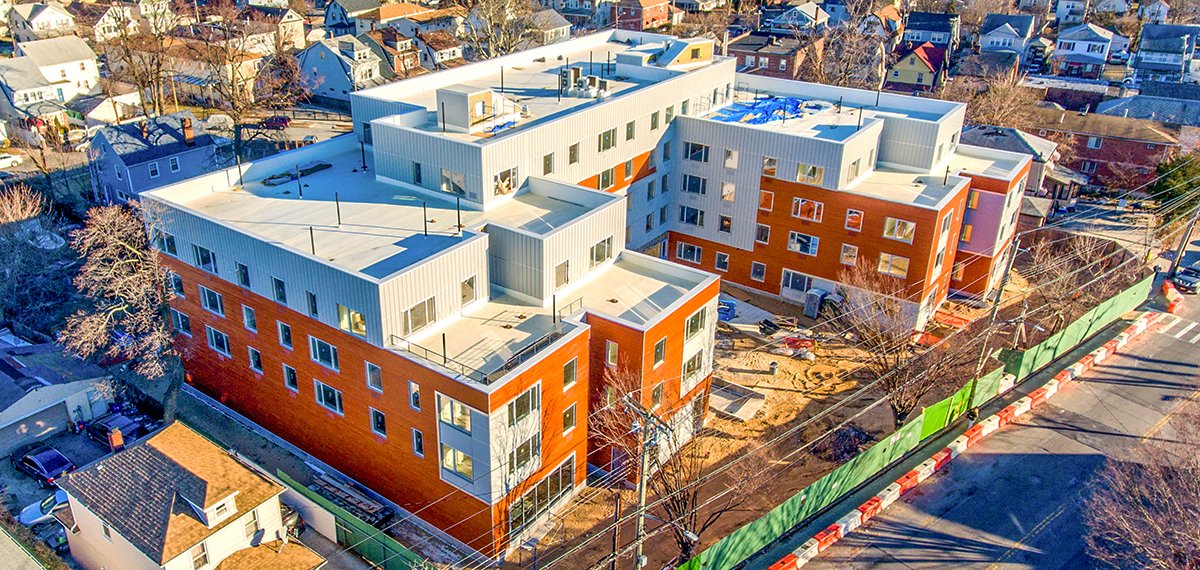
(photo: @NYCHousing)
The millions of New Yorkers struggling to deal with impacts of an urgent housing crisis deserve to see more collaboration between government officials and industry leaders who have the power to provide more affordable homes for low- and middle-income families.
Fortunately, the recently-passed state budget provides a reminder of what can be achieved when public officials advance smart, pro-housing policies with appropriate input and feedback from local leaders and those who build and preserve affordable housing. Alongside ongoing positive strides at the city level, New York City is well-positioned to further address its housing crisis and truly turn the tide in the months and years to come.
Just as importantly, this roadmap for crafting public policy – driven by an ongoing dialogue between the public and private sector – will help New York to more effectively mitigate recent changes at the federal level that have created some new challenges to maximizing affordable housing production.
Aside from continuing to advance New York State’s multi-billion-dollar commitment to financing affordable housing construction and preservation, the new state budget includes two prime case studies that demonstrate the benefits of increasing that kind of collaboration.
First, the state approved changes that will allow builders of affordable housing to utilize State Low-Income Housing Tax Credits (SLIHTC) separately from federal LIHTC. Previously, those credits could only be used together, even after recent federal tax cuts led to a devaluation in federal credits that made it harder to finance low-income housing.
Sensing the long-term implications of this challenge, NYSAFAH raised the issue directly with state lawmakers and administration officials. The result was a commonsense, pro-housing decision to split up, or bifurcate, the state and federal tax credits and to certificate the state credits – and these simple moves will attract millions in additional private financing for affordable housing each year, at no cost to the state.
Another area of fruitful collaboration involved a different issue regarding tax credits. The initial state budget proposal included a provision that would have deferred the use of several different credits – which play a crucial role in the production of affordable housing – for at least the next three years, and devalue the credits for a far greater period.
Again, NYSAFAH and other stakeholders understood from our experience on the ground that this was an area of tremendous concern. Taking pivotal tax credits off the table would have made it impossible to build and preserve affordable housing in communities that need it most.
And again, the conversations with and persistent advocacy before state officials led to a successful outcome – the tax credits were preserved and the affordable housing pipeline will continue to produce homes for low-income New Yorkers.
Together with the ongoing work at the local level, these statewide advances should demonstrate to all policymakers and stakeholders that open, fact-based dialogue is one of our best and most valuable tools in the fight to confront New York’s affordable housing crisis.
As NYSAFAH welcomes leaders from across the public and private sectors to its 19th Annual New York City Conference in the days to come, we have every reason to believe that these positive discussions will continue. And that is good news for all New Yorkers.
***
Jolie Milstein is president and CEO of the New York State Association for Affordable Housing (NYSAFAH). On Twitter @NYSAFAH.
***
Have an op-ed idea or submission for Gotham Gazette? Email This email address is being protected from spambots. You need JavaScript enabled to view it.
The Mayor’s Much-Needed Investment in Culturally Responsive Education
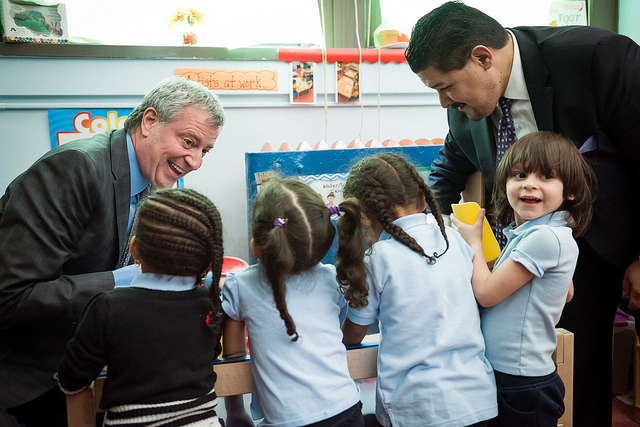
Mayor de Blasio & Chancellor Carranza visit a school (photo: Ed Reed/Mayor's Office)
Mayor Bill de Blasio’s announcement last week that the City is investing $23 million in culturally responsive education and anti-bias training in schools -- likely the largest investment of its type nationally -- is welcome news for New York City parents, educators, and researchers.
Education researchers have long-known that culturally responsive education (CRE) -- the practice of aligning curriculum and instruction with students’ backgrounds, life experiences, and cultures -- has a positive impact on improving student outcomes, especially for students of color. Just in the past two years, research has shown growth in student outcomes from having Black teachers, fostering positive racial identity, and taking Ethnic Studies courses.
Results from a new survey concur. They show that New York City teachers are eager to use CRE as a strategy to improve educational outcomes. According to the survey of nearly 400 city public school teachers conducted by the NYU Metro Center, a majority of teachers believe that CRE would improve their practice. However, a lack of preparation and expertise has limited the extent to which teachers can put CRE to practice.
The vast majority of respondents (87%) felt that teachers are responsible for helping students acquire the skills to critically understand, analyze, and respond to issues related to race and ethnicity. An even greater majority (93%) said they would be willing to modify their lessons to connect with students of diverse racial and ethnic backgrounds.
Until now, support for teachers to do this has been scarce, both in teacher preparation programs and in professional development offerings. Fewer than one in three (29%) of the teachers surveyed reported that they receive ongoing professional development on issues of race and ethnicity in the classroom, and only 10% indicated that they rely on the city Department of Education for this support. When tensions related to racial, ethnic, sexuality, or other identities arise between students inside schools, over half (55%) of respondents said they felt unprepared to intervene, and 93% said their colleagues would be unprepared to intervene.
The mayor’s announcement can begin to change that.
However, the city’s program must become bolder. In order for them to actually shift their practices to teach more effectively across differences, teachers will need a program of deep, ongoing training – not just a one-day workshop. Unlearning biases, being reflective about one’s identities, reconstructing curricula that are sustaining and relevant to students, and bridging the distance between student and teacher does not happen overnight.
Survey respondents call for more training on integrating race and ethnicity into their lessons, more resource materials, and more opportunities for relevant discussions with colleagues. They will need ongoing support to work effectively across lines of race and ethnicity, to ensure that teaching and learning is culturally responsive for all our children, and that teachers are culturally competent to teach them.
In this time of heightened visibility and awareness of racial bias in education, teachers are eager for ways to reach beyond differences to close gaps not only in student achievement but also between student and teacher. Schools Chancellor Richard Carranza, with his extensive history and track record with bridging cultural divides, is the right leader to make New York City a national model in the area of culturally responsive education.
We hope that New York City can now finally and truly make culturally responsive education the core of its strategy for educating all students, particularly those most implicated by cultural bias.
[Access the full survey findings here.]
***
David Kirkland is the Executive Director and Jahque Bryan-Gooden is a Research Analyst at the NYU Metropolitan Center for Research on Equity and the Transformation of Schools.
***
Have an op-ed idea or submission for Gotham Gazette? Email This email address is being protected from spambots. You need JavaScript enabled to view it.
City, MTA Must Look Under the Hood for Greater Climate Progress
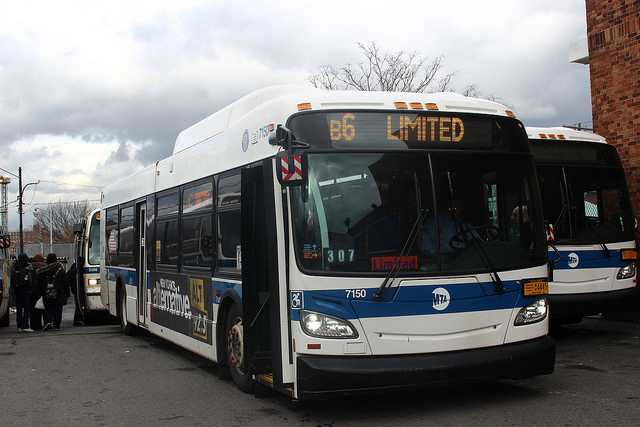
An MTA bus (photo: MTA Bus)
The new congestion pricing surcharges on taxis and on-demand ride services below 96 Street in Manhattan are designed to address congestion in midtown, but they generate more controversy than impact. They might raise a few hundred million dollars a year for the MTA to fix the subway. But they won’t do anything to reduce congestion or air pollution. Meanwhile another big ticket MTA budget item has gotten little attention but will have a huge impact on New York City's emissions, air quality, and public health: bus procurement.
The MTA plans to spend over $300 million this year and $1.38 billion over the next four years to buy about 1,700 new buses. Some 1,300 of them – roughly a billion dollars’ worth – are slated to be diesel-fueled, and therein lies the rub. Diesel vehicles were powerful and efficient for the 20th century, but they are big polluters. Much better 21st century alternatives exist.
Analysis by Energy Vision recently submitted in testimony to the City Council shows that diesel buses and trucks on our streets generate a disproportionate share of adverse impacts on New York City’s climate, air quality, and health. Across the City’s municipal fleets, its 10,000 medium- and heavy-duty trucks consume 60% of the fuel, emit 63% of GHGs, and are a major emitter of health-damaging nitrogen oxide (NOx) and particulates (PM). Thousands of MTA diesel buses compound the problem. According to Dr. Philip J. Landrigan, head of Global Health at Mt. Sinai, eliminating diesel buses and trucks from our fleets would reduce New Yorkers' childhood asthma, heart disease, lung cancer, strokes, and health care costs.
New York City has ambitious goals for achieving the best air quality of any major U.S. city by 2030 and for cutting GHGs 80% from its municipal fleet vehicles by 2035. This year Mayor de Blasio announced the City would go “fossil free” by divesting its pension funds from fossil fuel stocks. Realizing these ambitions is vital for the climate, our health, and our kids' futures. But there is little chance of that if the City and the MTA continue to purchase more heavy-duty diesel trucks and buses.
The MTA will buy 110 new natural gas buses this year, which is significant. But its fleet of 5,700 buses already includes over 4,500 diesel buses, plus the 1,300 new diesels it plans to buy over the next four years.
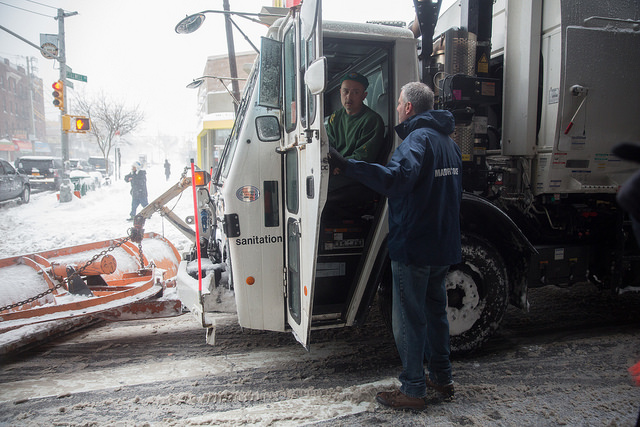
The City Department of Sanitation (DSNY), which operates the largest refuse fleet in the country -- more than 2,200 collection trucks -- runs virtually all of it on biodiesel, which is 80% ordinary diesel fuel. It has just 42 natural gas trucks, and it buys hundreds more diesel refuse trucks every year.
We can do better. New York is now far behind other world-class cities in weaning itself off diesel. London has already stopped procuring diesel vehicles for its fleets as of this year because of their health and climate impacts. Eleven other major cities are pledging to follow its lead, including Oslo, Rome, Beijing, and Shanghai.
In fact, New York City is one of those 11. The MTA and the City can and should start phasing out diesel vehicles now.
The questions are, what alternatives should replace them and how fast could they ramp up? The MTA is piloting electric buses, which are quiet and have zero tailpipe emissions. But they cost a whopping $300,000-$400,000 more than diesel per vehicle. The City is aggressively deploying light-duty electric vehicles and charging infrastructure, but electrification of its heavy-duty trucks is not yet a commercial option, especially for refuse trucks, since they don’t have enough power to both collect garbage and plow snow.
There’s a better way to decarbonize New York’s heavy vehicles. The MTA and the City could do what other cities are doing: buy more natural gas (CNG) buses and trucks equipped with efficient engines that cut emissions and can run on renewable fuel.
The new “Near Zero” natural gas engine, certified by the U.S. EPA, has taken clean burning to a new level. It cuts health-damaging nitrogen oxide and particulate emissions 90% below the EPA’s most stringent standard. Near Zero buses and trucks are only about $50,000 more than their diesel counterparts. They are just as powerful and serviceable and are 50-80% quieter than diesel engines.
They can run on conventional CNG, but even better, they also run on biomethane or Renewable Natural Gas (RNG). RNG is chemically similar to conventional natural gas, but it is not a fossil fuel. It’s made from a renewable resource: organic waste, such as food waste from homes and businesses, the sewage that goes to wastewater plants, agricultural manures, and more. Instead of drilling, RNG is produced by collecting and refining the methane biogases emitted by those organic wastes as they decompose, in special tanks called “anaerobic digesters.”
The resulting fuel isn’t just clean-burning; it is the lowest-carbon fuel available. When made from food waste or animal manure, it is actually net carbon-negative over its lifecycle. In other words, making it captures more greenhouse gases (which would otherwise escape into the air as the waste breaks down) than are emitted by the vehicles burning it for fuel. There’s no faster, more cost-effective, or climate-friendlier way to cut fleet emissions.
The MTA already has 800 buses and DSNY already has 42 refuse trucks that use conventional CNG. With a simple change in fuel contracts they could run on RNG overnight. The RNG could be delivered through the same natural gas refueling stations that now supply conventional natural gas, and at the same price.
There is plenty of RNG available in the U.S. Over 40 projects are processing decomposing organic wastes into vehicle fuel across the country. More are under development in the New York region that could make fuel for our municipal fleets from our own waste streams. The roughly 1.2 million tons of food waste generated in New York City each year could make enough RNG to power all the trucks in the City’s fleets, turning a costly waste burden into a valuable energy resource.
Nationwide, there is enough RNG production potential to power the refuse, bus, and airport fleets of every major U.S. city. Some 20,000 buses and trucks across the country now run on RNG. Los Angeles Metro has purchased 295 RNG-fueled “Near Zero” buses, with an option to convert its entire 2,200 transit bus fleet. Santa Monica’s “Big Blue Bus” fleet converted to RNG completely, and more municipalities are following suit.
So what is New York City and the MTA waiting for? Getting our heavy vehicles off diesel is the single biggest step we can take toward a sustainable transportation sector, and would propel us toward meeting the City’s clean air, climate, fossil fuel elimination and waste prevention goals. It’s high time we got started.
***
Joanna D. Underwood is founder and board member of the national environmental organization Energy Vision, which researches, analyzes and promotes viable technologies and strategies to transition to a sustainable, low-carbon energy and transportation future. On Twitter @Energy_Vision.
***
Have an op-ed idea or submission for Gotham Gazette? Email This email address is being protected from spambots. You need JavaScript enabled to view it.
Driver’s Licenses for All Would Better Many Lives, Including Mine
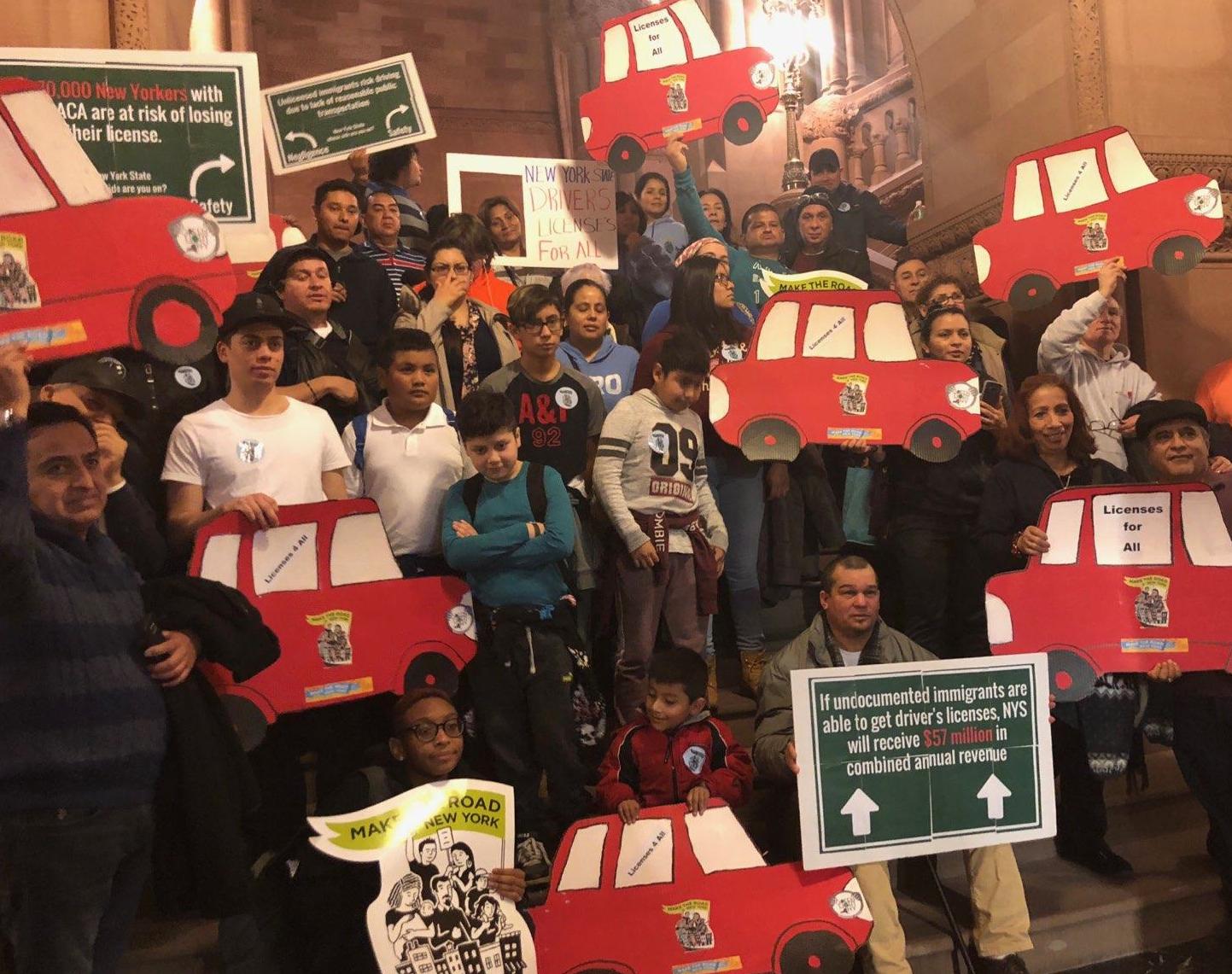
Make the Road New York members rally in Albany for driver’s licenses for all
Every morning, I drive with my wife to work. My commute is the scariest part of my day - and not because of the traffic. It’s because I know that a routine traffic stop could lead to me being separated from my family forever.
I’m an undocumented immigrant, and New York will not currently allow me to get a driver’s license. For New Yorkers like me, it’s way past time for our state to step up and do what other states have done: ensure that all qualified drivers, regardless of immigration status, can have access to a license.
The attacks by the Trump Administration continue to get worse. Trump’s Immigration and Customs Enforcement (ICE) officers are using every excuse to detain and deport immigrants alike and tear us from our families, as they did in detaining 225 immigrant New Yorkers one recent week. They’re especially using minor traffic violations.
That’s why I recently joined fellow immigrants and advocates from across New York State to call on the State Legislature -- starting with the Assembly -- to restore access to driver’s licenses to all New Yorkers.
This bill would change my life, and my family’s too. I have lived in the United States for nearly 20 years and I wish I could be eligible to adjust my immigration status, but at the moment due to our current broken immigration system, that is not possible. There is no clear path for me to be able to adjust my immigration status, but other measures can be helpful to me and others like me.
I live in Long Island with my wife and two children. Every day, I leave my house to drive to work, with uncertainty and fear. Where I live, there is a lack of public transportation. It can take hours to get anywhere by bus or train, and taking a taxi is too expensive. I have to drive because I cannot afford to be late to my job and I need to be able to go to the store, take my children to their doctor appointments, and pick them up from school.
I was once stopped at a traffic stop by police. I was given a ticket for driving without a license and needed to go to court. I couldn’t sleep due to the fear I felt of going to court and possibly being separated from my family. I went to court and, with the legal fees of my attorney, I ended up paying almost $700. Thankfully it wasn’t worse than that -- and it now easily could be.
In my home country in Latin America, I had my driver’s license, but right now, due to my immigration status, I am not able to get a driver’s license in New York State.
Expanding access to driver’s licenses to all New Yorkers makes sense. If it passes, immigrants will be able to register, and insure their vehicles in New York, creating an economic boost. A 2017 analysis by the Fiscal Policy Institute determined that New York would receive an estimated $57 million in combined annual revenue.
Allowing driver’s licenses for all will improve public safety by making sure that all drivers on the road are licensed. States like California have already been experiencing the positive effects of granting undocumented immigrants access to driver’s licenses since 2015. A Stanford report released last year found there had been a significant decrease in hit-and-run accidents.
At a time when the Trump Administration’s attacks on our communities continue, passing this legislation would demonstrate that New York stands up for everyone, regardless of their immigration status. New York has delayed too long; we need to do more to stand against the White House anti-immigrant rhetoric now.
Obtaining a driver’s license will change my life, my family’s life, and that of thousands of New Yorkers. It would mean being able to pick up my children from school or take them to the doctor without fear. And it would help me to potentially get a promotion at my current job, or be able to look for better one.
There are 12 states, including Connecticut and Maryland, that currently allow undocumented immigrants access to driver’s licenses. The new governor of our neighboring state, New Jersey, has committed to follow those states and expand access to driver’s licenses. But we haven't heard a commitment from Governor Cuomo yet. New York should be next.
***
Jorge Cotraro is a Long Island resident and a member of Make the Road New York, the largest grassroots community organization in New York offering services and organizing the immigrant community. On Twitter: @MakeTheRoadNY.
***
Have an op-ed idea or submission for Gotham Gazette? Email This email address is being protected from spambots. You need JavaScript enabled to view it.
State Budget Does Help Mass Transit, But MTA Capital Plan Uncertainty Rising
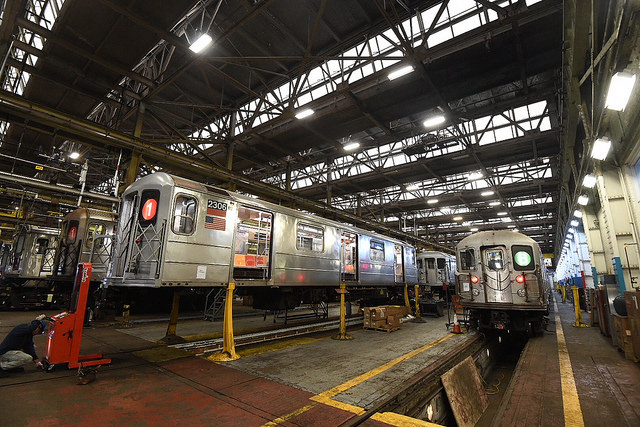
(photo: Don Pollard/Governor's Office)
The MTA received two significant infusions of new money in the state budget effective April 1. The first is the full $836 million, to be provided to the MTA by December 31, to fund phase one of the Subway Action Plan developed last July by Chair Joseph Lhota and MTA management. The second is through a new tax, starting January 1, on for-hire vehicle trips by taxis, Ubers, Lyfts, and others for trips in Manhattan south of 96th street. The tax revenue will put an estimated $400 million a year into the MTA budget to provide regular, ongoing support for the increases in maintenance related to the Subway Action Plan.
The new money is very welcome for the beleaguered transit system, but major policy and funding questions like the MTA’s long-term capital construction program and whether a congestion pricing program will become integral to future sources of funds remain unanswered.
The $836 million to be delivered in 2018 is a combination of about $500 million in operating funds to cover the expense of several thousand new maintenance positions in subway car overhauls, replacing track and signals, deploying emergency personnel, and other staffing, with the rest investments in related physical assets. Half the money for the 2018 infusion was initially put into the proposed executive budget submitted by Governor Cuomo to the Legislature from state funds. The State Legislature agreed to that and also to compel the City of New York to come up with the other half of the funds, $418 million, despite Mayor de Blasio’s objections to the city being required to provide the money when proposed last year after Governor Cuomo declared a transit emergency. The ongoing deterioration of subway service that led to the emergency declaration impelled the Legislature to agree that both the State and the City must provide additional support to the MTA.
Two other proposals in the budget by the governor to force New York City to pay even more money to the MTA were rejected by the Legislature, with the Assembly specifically denying the approvals in both its one-house budget and later in its summary of the enacted budget. These proposals were viewed as far more onerous than the Subway Action Plan mandate. One required the city to pay the full cost of the New York City Transit Capital Plan, which is supposed to be $17 billion over the five years of the current 2015-19 MTA plan. Right now the city’s scheduled contribution is $2.5 billion.
The second proposal would give the MTA the authority to determine how much property tax revenue in New York City it could take from “value capture.” This budget bill would allow the MTA to decide how much property tax value is added due to transit improvements it makes in certain zones around the city, and then direct the incremental property tax revenue to itself without the city having a right to approve it, or even have a say in how much money is involved. The Citizens Budget Commission called this proposal “confiscatory.“ Although rejected, versions of these proposals are likely to resurface in the future as the Cuomo administration tries to find ways to shift financial responsibility from the state to the city to fund the MTA.
The State Assembly deserves thanks from the public for the $400 million for-hire vehicle trip surcharge for mass transit. Governor Cuomo never put legislation to create a congestion pricing plan into his proposed budget, despite endorsing the concept last summer and creating the Fix NYC Advisory Panel, which offered a congestion pricing framework in a report that was released at the time of the budget. However, in early March the State Assembly, in its one-house budget, proposed the surcharge to fund the recurring maintenance program. A similar surcharge had been a lesser part of the Fix NYC report, which called for a three-year, three-phase program, the main element of which is a charge to enter Manhattan south of 60th Street for most vehicles, designed to yield up to $1 billion a year. But Governor Cuomo put none of it into his budget plan.
Governor Cuomo had the good sense to rapidly endorse the Assembly’s trip surcharge, and it was approved by the Senate after the tax was limited solely to Manhattan, with no new charges in the outer boroughs or the suburbs. But there is no other element of a congestion pricing set-up. There is no funding for any infrastructure to electronically record entries into the Manhattan business district, which is phase two of the Fix NYC plan. Existing technology in the taxi and for-hire vehicle industry will pinpoint when those vehicles traverse Manhattan south of 96th Street.
Congestion pricing remains in limbo, even as the MTA’s long-term capital construction budget may unravel. In March of this year Standard & Poor downgraded the MTA’s bond rating one notch after an MTA report showed the agency would have a $400 million operating deficit in 2020 and a $600 million operating deficit by 2021, even after two fare and toll hikes. The primary cause of the deficit was reported to be a drop in real estate transaction revenues like the mortgage recording tax, which in part are dedicated to mass transit.
The $32 billion 2015-19 MTA Capital Plan, to which the MTA is now committing significant funds as it finally wraps up the prior plan, includes $11 billion from the MTA itself, primarily from money it will borrow. The forecasted deficits, however, are very likely to constrain the ability of the agency to actually borrow that much money. Not only that, but state government’s share of the 2015-19 Capital Plan, $8.5 billion, included $7 billion for which there was only an I.O.U. with no stream of revenue to back it up. Shortfalls in the 2015-19 Plan could materialize soon, just as discussions about the next five-year capital plan are moving forward.
The MTA has to propose its 2020-2024 Capital Plan in October 2019. The recent five-year plans have cost about $30 billion each - but if the current plan begins to unravel the 2020 plan will be in trouble. A fall 2017 State Comptroller report expressed concern that the 2020 plan might have shortfalls (meaning lack of sources of funding to pay for projects) similar to the $15 billion shortfalls that plagued decision-makers for both the 2010 and 2015 plans before funding schemes were patched together.
The public and the State Legislature need critical information from the MTA very soon to determine the agency’s ability to sustain a meaningful capital program. In 2007 the Legislature made the MTA accelerate submission of its capital plan at that time, earlier than the law had provided, and it could do so again, scheduling a submission for early 2019, rather than the end of the year, to get a better handle on what the problems really are.
Congestion pricing involves rational policy proposals to deter vehicles from entering Manhattan to reduce pollution and congestion, and provide a long-term funding stream for the MTA. But this is the second time in ten years a push for congestion pricing has not been successful in the State Legislature. If congestion pricing won’t fly there is no shortage of possibilities for taxes to fund the mass transit system. There are payroll taxes, personal income taxes, corporate income taxes, sales taxes, millionaires’ taxes, mansion taxes, you name it. The issue is the political will. A consensus on funding this most vital of services remains frustratingly elusive, along with the leadership to forge that consensus.
***
Jim Brennan was a member of the New York State Assembly for 32 years, where he chaired four committees. On Twitter @JimBrennanNY.
***
Have an op-ed idea or submission for Gotham Gazette? Email This email address is being protected from spambots. You need JavaScript enabled to view it.
Byford's Big Bus Plan Relies on City, State Cooperation
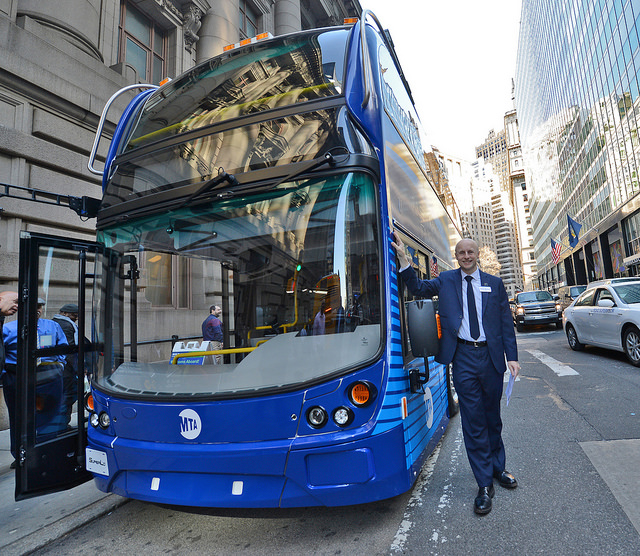
(Credit: Marc A. Hermann / MTA New York City Transit)
In the Big Apple's transit circles, Andy Byford has quickly become the hottest London import since the Beatles. New York City Transit's new president, brought in this winter from his job as the head of the Toronto Transit Commission, faces the unenviable task of fixing the city's ailing subway system and restoring faith in its vital transit network. Just three months into the job, Byford is moving at a breakneck pace, and on Monday, he unveiled an ambitious plan to speed up New York City's snail-like local buses and fight the tide of declining ridership.
The plan sets the bus system on the right road toward improvement but will require city and state cooperation and a change in NYPD culture, two elements in short supply these days that could torpedo Byford’s best efforts. It is also likely to require more money, which is also in short supply.
The New York City bus system is a curious thing. It is notorious unreliable with buses that crawl through city streets stopping every two or three blocks and with average speeds that barely exceed eight miles an hour. With infrequent and unreliable service, ridership has declined by nearly 10 percent since 2012 and 15 percent since 2002. Still, over 2 million riders a day rely on the city's buses, and the bus system needs to be fixed.
Byford's bus plan comes after nearly two years of heavy lobbying from the Bus Turnaround Coalition, a joint effort by the Transit Center, Riders Alliance, Straphangers Campaign, and Tri-State Transportation Campaign. In 2016, this group called for an overhaul of the way buses work in New York City, and in 2018, Byford acknowledged its work in unveiling his plan. "We’ve listened to our riders’ concerns," he said, "and are working tirelessly to create a world-class bus system that New Yorkers deserve."
So what exactly is the plan? For now, it is an aspirational approach to better bus service with a 28-point agenda.
Byford wants to redesign the network by optimizing routes based on ridership needs while eliminating some stops to speed up service and expand off-peak bus frequency. He wants to implement infrastructure upgrades that prioritize buses over other vehicles, including dedicated lanes and a signal prioritization system that allows buses to hold green lights or shorten reds. He calls for NYPD cooperation and effective traffic enforcement, and he proposes a faster boarding process, currently a main source of delays.
To reduce bus dwell time -- the minutes a bus spends sitting at a stop while riders dip their Metrocards or scrounge around for $2.75 in nickles, quarters, and dimes -- Byford suggests all-door border, similar to London's bus system; a tap fare payment card; and cashless bus fares. The final parts of the plan involve customer-focused improvements including more real-time bus countdown clocks, redesigned system maps, and more bus shelters along with some clean-tech buses to replace New York's current gas-guzzlers.
On its surface, the plan is exactly what New York needs. Byford has shown that he understands the problems and drawbacks with the current bus network and is willing to propose a multi-part solution that involves every stakeholder and seemingly transcends the dysfunctional politics of the relationship between the city and state. But unfortunately with such an aggressive plan in play, each of these stakeholders are going to have to work together for this bus revitalization effort to succeed.
And to that end, except with respect to the all-door boarding and other technological upgrades to the buses themselves, Byford is now almost a bystander as he has shifted the onus to the city Department of Transportation, the NYPD, and Albany lawmakers to work together to realize his vision of a better bus network.
Let's start with the city's Department of Transportation. Since DOT controls the city's streets, any changes to the way street space is allocated will have to start with DOT. Thus, additional bus lanes, dedicated bus corridors and the queue-jumping benefits of signal prioritization require DOT buy-in and support, and so will reducing the number of bus stops and changing street design to better support bus infrastructure. NYC DOT Commissioner and MTA Board member Polly Trottenberg voiced support for the plan during Monday's meetings, but her boss, the mayor, a reluctant and infrequent transit rider who virtually never takes the bus, will have to be a forceful ally supporting these changes.
And then we have the NYPD. Currently, the NYPD seems to view the city's bus lanes as, well, parking spots. Take a ride down the East Side's avenues, and bus lanes will inevitably be filled with cops who have decided to park in curbside bus lanes, thus negating their intended purposes. The MTA, on the other hand, expects cops to be willing partners in enforcing bus lane restrictions and generally helping to ensure that other vehicles are not in the way of buses, impeding speeds and progress through congested city streets.
But cops alone are a poor and inadequate enforcement method, and NYPD culture is tough, if not impossible, to change. Thus, Albany takes center stage as bus lane enforcement should be automated and camera-based. Until now, the state Legislature has resisted giving the MTA carte blanche ability to install cameras that can assist in automated bus lane enforcement, but to truly tackle the problem of cars in bus lanes, Albany will have to act, and forcefully.
Finally, the elephant in the room is the cost. We do not yet know how much the bus plan will cost. It relies in part on moving pieces that are funded (such as a new fare payment system) and others that are not, and it will again be up to the governor to champion transit improvements in New York City so that they receive adequate funding. Facing the pressures and, more importantly, the headlines of a primary challenge, Andrew Cuomo has lately embraced certain positions he has rejected in the past, and mass transit support should be one of them. Perhaps, then, the time is right for the city and state to prioritize bus travel over car traffic.
Ultimately, the buses need fixing, but more importantly, the bus system needs to work efficiently so that New Yorkers have faith in it again. Buses can solve access problems in transit deserts and can be a part of the transit upgrades that a true congestion pricing plan would require. Byford has a vision that will improve bus service, but that is the easy part. Now he just has to convince everyone else to join him as well.
***
Benjamin Kabak is the editor of Second Ave. Sagas, on Twitter @2AvSagas.
***
Have an op-ed idea or submission for Gotham Gazette? Email This email address is being protected from spambots. You need JavaScript enabled to view it.
A Doctor’s Perspective: Marijuana Legalization Now

(photo: Cannabis Doctors of New York)
New York’s Compassionate Care Act went into effect in January 2016. As the CEO of Cannabis Doctors of New York, a group based in Manhattan, I’ve been at the forefront of treatment using cannabis and have seen the life-changing results its thoughtful and judicious use can provide. Prescription marijuana medication has helped my patients safely cope with a variety of serious ailments such as cancer, AIDS, chronic pain, and Inflammatory Bowel Disease. However our state’s marijuana policy is about to be quickly surpassed by the policies of our neighbors to the east, west, and north in ways that would hit the New York Metropolitan Area particularly hard.
I am urging lawmakers to consider the unfairness of this situation. All law-abiding New Yorkers should be able to have access to the analgesic and other therapeutic qualities of cannabis. Used responsibly, marijuana can be a powerful and important tool in a healthy lifestyle. And it is a vastly better alternative to the drug scourges eating away at our society. For thousands of years the many uses of cannabis have been woven into societies around the world. There has never been a documented overdose.
Meanwhile, a growing body of research proves that cannabis is an effective tool in safely treating ailments that are now being treated with opioids and in fact, it is being shown to help wean patients off narcotics. As a doctor, I’ve seen these results.
Some 9,000 New Yorkers overdosed on opioids last year. Tens of thousands of Americans lose their lives every year due to alcohol — a legal yet far more dangerous substance than marijuana. Enough is enough. It’s time for New York to join the 21st century and pass the pending legislation that would expand the current medical cannabis law and allow our responsible MDs to use their judgement in treating the many conditions that could be helped by cannabis (and that were originally included in the Compassionate Care Act). New York needs better patient access.
This is a social justice issue and an economic issue, in addition to being good medical policy, as is seen every day in New York and the 28 other states plus the District of Columbia where medical cannabis has been legalized. The high approval rating amongst Republicans, Democrats, and independents makes the issue politically safe for elected officials on both sides of the aisle.
Legalization of the recreational use of marijuana in the Empire State could bring $2.5 billion in tourism a year. Much of that money would be spent in the New York City Metropolitan Area (and has been shown in other states would help lower the high price patients are forced to pay now for medical cannabis). Tens of thousands of good jobs would be created, and hundreds of millions of dollars of tax revenue would be pumped back into the economy to be spent on schools and budget shortfalls. Does our state want to lose billions of dollars to neighboring states and then play catch-up?
It’s disturbing that our leaders in Albany have fallen so out of touch with the times. Right now 20% of Americans live in a state with legal marijuana; 64% of Americans approve of legalized marijuana, and this issue crosses party lines. New York prides itself on being a liberal standard bearer, but on this issue it is sorely lacking leadership. Progressive attitudes just a few miles away are creating jobs and peace of mind and safety for millions of marijuana users. It’s time for us to get with the program. An economic boost, thousands of good jobs, and a more compassionate public health policy is just a bill away.
***
Dr. Kenneth Weinberg is CEO of Cannabis Doctors of New York.
***
Have an op-ed idea or submission for Gotham Gazette? Email This email address is being protected from spambots. You need JavaScript enabled to view it.
The Mayor's Mistaken Attempt to Supersize Buildings
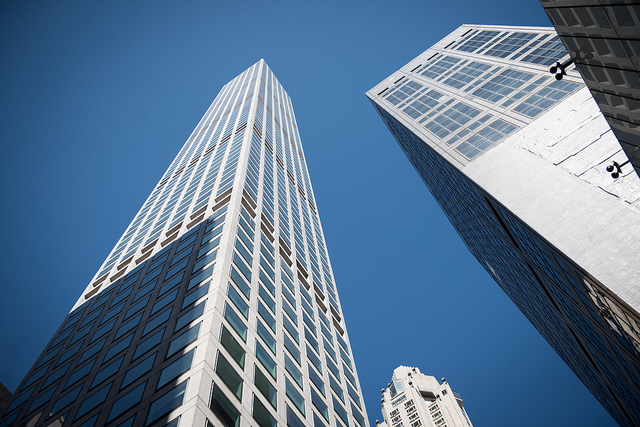
(Credit: Michael Appleton/Mayoral Photography Office)
Nearly every day it seems, a new record is broken for a tallest new residential structure in our city. Whether it is Downtown Brooklyn’s first 1,000+ foot tall tower, Queens’ tallest tower in Long Island City, or the 1,550 foot tall West 57 Street residential tower that will soon rise higher than the top floor of One World Trade Center, residential building in New York City is reaching new heights.
But for Mayor de Blasio and the real estate industry, even these record-breaking heights are not enough. They are advocating for repealing a 60-year-old state law, which, while capping the size of residential developments in New York City, is still so generous as to allow the unprecedented giants going up now.
If the mayor and the real estate industry have their way, the sky could literally be the limit for residential high-rises in New York City. And not just in Midtown or the Financial District, but residential neighborhoods like the Upper East Side and Upper West Side, Greenwich Village, and various parts of Brooklyn and Queens, where current rules limit new residential development to at or near the cap imposed by state law.
The possibility is more than theoretical. Two years ago proponents of lifting the cap came close to getting the State Legislature to do so. This year the State Senate pushed for the measure to be included in the state budget, but the Assembly ultimately did not go along with it (though the cap removal definitely has its proponents in the Assembly majority). Most observers expect the supporters of lifting the cap to push the measure again before the state legislative session ends in June, possibly as part of the “big ugly” – the annual package of often unrelated and controversial measures passed in the final hours of legislative session, with little public notice or input.
With all the problems facing New York City right now, from dysfunctional subways to crumbling public housing to crippling congestion, why is this an issue the mayor has chosen to take on?
Mayor de Blasio and some of the proponents of lifting the cap claim it’s necessary to build affordable housing. But not because they want affordable housing developments that exceed the current record-breaking heights. Because they want to allow real estate developers to build vastly larger for-profit, luxury housing developments. In return, they will require them to attach a comparatively small amount of affordable housing to the development.
This is a false dichotomy that the real estate industry has promulgated and the mayor has endorsed – that the best and, in many cases, only way to get new affordable housing out of for-profit developers across the city is by supersizing the amount of luxury, market-rate housing they can build, and then attaching these smaller amounts of affordable housing to it.
It’s due to this approach that communities throughout New York City have opposed the mayor’s rezoning plans – both because they would destroy the scale and character of their neighborhoods, and because under the guise of introducing “affordable housing” (which in many cases is unaffordable to the residents of the neighborhood), vastly increased quantities of very expensive housing is built, which more than counteracts any good done by the relatively small amount of affordable housing created.
Take Greenwich Village and the East Village. These increasingly wealthy neighborhoods with decreasing affordable housing have been begging the mayor to support a zoning plan we have proposed that would allow modest increases in the allowable size of developments as a condition for creating or preserving affordable housing. The mayor has adamantly opposed the plan, saying he would only be willing to consider the kind of massive increases in the allowable size of residential development that would bump up against the current state cap, to say nothing of destroying the character of these human-scaled neighborhoods.
Don’t let the mayor or Big Real Estate fool you. The state cap on the size of New York City residential buildings is not limiting anything New Yorkers should be worried about. The only thing it’s limiting is the already astronomical profits of developers, and the ambitions of some politicians to increase them even further.
***
Andrew Berman is Executive Director of Greenwich Village Society for Historic Preservation. On Twitter @GVSHP.
***
Have an op-ed idea or submission for Gotham Gazette? Email This email address is being protected from spambots. You need JavaScript enabled to view it.
The Great Select Bus Service Conspiracy: Part III
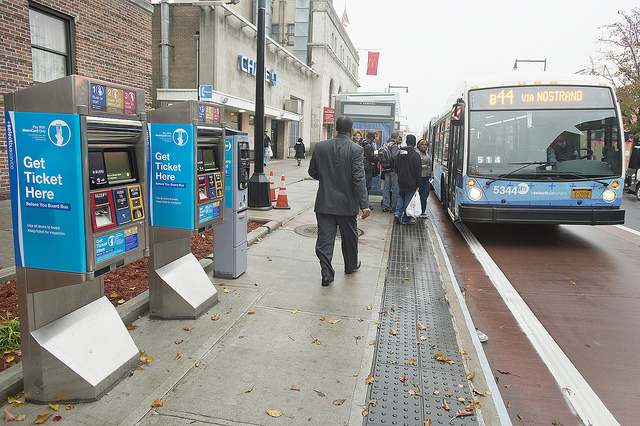
(photo: MTA/Patrick Cashin)
This is part three of a three-part series
Previously discussed: the promises and the reality, the difference between bus travel time and passenger travel time, who benefits and who is hurt by SBS, how the mayor, MTA and DOT mislead, the true costs of SBS (part one); the denigration of local bus service, problems with enforcement, other SBS problems, negative effects on traffic and local businesses and how public participation is inadequate (part two).
Not a Cure-All
SBS is not the cure-all for local bus service problems as purported to be. Some SBS routes do not even make sense. In one case, there is a nearby unused rail line that could be reactivated at a fraction of the cost of constructing a new subway line without disrupting traffic and local businesses as SBS does. Yet it was never considered as an alternative to the Woodhaven Boulevard SBS.
The MTA and DOT want to spend $2 billion on SBS over the next ten years, but will not alter, add or extend existing bus routes to fill transit deserts. Some have been indirect or outdated for over 70 years. The MTA claims it would cost too much to increase service because they refuse to consider the resulting additional ridership from better service. They have rejected route improvements with increased annual operating costs of only $50,000.
Instead, they make foolhardy proposals to eliminate bus stops, such as on the Q22 where there is a high elderly population. The MTA suggested those riders use Access-A-Ride instead. Each one of those trips costs the MTA over $50. New bus routes are scheduled only at 30-minute intervals, which the MTA insists is sufficient. The actual wait for a bus is often longer. Is it any wonder that these routes are among the most lightly-utilized routes in the system?
Important transfer points are missing from SBS routes. For example, there is no way to transfer between the Q52/53 and the B15 Kennedy Airport route, which is also slated for the SBS treatment. “Dollar vans” continue to illegally compete with MTA buses, draining revenue from the MTA.
There is no desire by the MTA to connect new neighborhoods, thereby really improving mass transit. In most cases, SBS is merely replacing existing Limited Stop routes. The Southern Brooklyn SBS needs to connect Bay Ridge with Gateway Mall and Kennedy Airport, not just replace the B82. Potential economic benefits of such new routings are ignored. SBS construction costs (if applicable), operating costs, and ridership are the only variables considered.
How does the mayor know that 21 additional routes will be needed in the next ten years even before any SBS meetings are held? Why aren’t other solutions being discussed or analyzed? Perhaps routes need to be altered or added, more short services need to be provided or a zone express would make more sense than SBS. A short service does not operate for the entire length of the route. A zone express is a bus that picks up passengers bound for a single destination such as a major subway stop until it is full and then operates non-stop the rest of the way.
Can SBS Work?
Yes, if it is done correctly.
By imposing a deadline on DOT for 20 routes by the end of 2017, the mayor rushed the planning process so that some routes were not properly designed. It is now difficult or impossible for trucks to turn onto the Woodhaven Boulevard service roads, necessitating lengthy detours. SBS is most beneficial on very long routes where the average trip length is much greater than 2.3 miles. On the S79, for example, many riders travel a considerable portion of the route, at least five miles, and some travel ten or more, so many do save time. However, the S79 only includes three SBS features (two is the minimum number required to qualify as an SBS route), exclusive bus lanes (rush hours only), and longer distances between some stops than Limiteds; and more recently, TSM. There is no off-board fare collection, hence no additional enforcement costs, and standard 40-foot buses are used so there are no extra labor or fuel costs.
The effect on other traffic resulting from the bus lanes must also be considered to determine if the benefits afforded bus riders are greater than the harm done to motorists. The S79 Progress Report showed that traffic volumes declined on both Hylan Boulevard and parallel roadways. That is understandable when traffic congestion increases, which it did. That does not indicate a lower demand, but a lengthening of the peak period. We know congestion increased because in one instance the time it took to travel between two points increased by 50 percent from 10 to 15 minutes, but declined to a lesser extent in other instances. DOT explained away the time increase by attributing it to “daily roadway fluctuations.”
Responsible traffic studies do not draw conclusions from just two days, and Mondays and Fridays usually are not studied because they are atypical of weekday travel. If DOT averaged three midweek days before and after implementation and allowed at least a month for drivers to become accustomed to the elimination of traffic lanes, perhaps then it would be clear if the increased travel times were really a result of daily fluctuations or not. DOT, however, is really only interested in the effects on bus riders, not on other traffic.
Other routes may also work fairly well like the Bx6, the Bx12, and the Q70. The M15 works well in the late evenings, providing a quicker alternative than the subway from the southern tip of Manhattan to the Upper East Side.
Proposed routes such as the B82 could work if they connect new neighborhoods. The B44 could have been designed better so that Kingsborough College students were better served and employees of Kings County and Downstate Medical Centers were not so inconvenienced. That, however, would have involved creating or rerouting other bus routes in the area to fill a needed service gap, something the MTA is hesitant to do. It also would have required public hearings. The MTA usually prefers the easy way over the correct way.
B44 SBS ridership south of Avenue X would greatly increase to at least a seated load per bus if a branch to serve Kingsborough Community College were instituted as was first proposed in 2013. No increase in service would be necessary because new riders would ride in the off-peak direction. Presently the 60-foot buses south of Avenue X only carry six or fewer passengers even during rush hours, except for a handful of trips when health care workers are changing shifts.
Both proposals were made to the MTA or DOT and have been dismissed or ignored.
Is SBS worth it?
Consider that a simple state law requiring all non-emergency motor vehicles to give the right of way to buses pulling out of bus stops would save bus passengers more time than SBS because it would apply to all 326 bus routes, not only 17 or 38 SBS routes. It would also save the MTA money by shortening bus travel times. Best of all, it would cost virtually nothing, and would disrupt traffic less than exclusive bus lanes.
The first SBS route began in 2008. Using 2011 as a base year and adding up the riders in the 12 SBS corridors we get 101,455,632 passengers. For 2016, the number is 98,800,534 passengers, or a 2.6% decline, while all local routes (NYCT and MTA Bus) declined by 3.3%. (It should be noted that the Q70 became an SBS route in 2015.)
Ridership on SBS routes declined by 0.86% from 2015 to 2016 while the system in general declined by 1.5%. SBS routes performed slightly better than all local/limited routes but did not reverse the declining trend in bus patronage, one of its goals. The M15 First and Second Avenue route alone lost over 3 million annual passengers between 2012 and 2016, more than the total bus ridership in many cities, and that does not consider the opening of the Second Avenue subway. Many local riders could have just decided that walking is now quicker with less frequent service.
Another possibility is that patronage didn't actually decline on SBS routes but fare evasion on those routes is higher than on routes where you pay on board. The MTA insisted for a long time that a fare-evasion rate of three percent was acceptable and within industry standards. After a newspaper expose, it finally admitted fare evasion on local bus routes was 14 percent and took temporary mitigating actions to reduce it.
Fare evasion rates for SBS are unavailable. The MTA admits that each SBS inspector costs $100,000 per year in salaries and accounts for the biggest ongoing cost. But how much enforcement is there? One daily SBS rider claimed to have seen the Eagle team on the bus only once in the past year. We need to know if fare evasion rates for SBS are higher than on traditional bus routes.
What will happen to all the fare machines, which cost $50,000 each, when they become obsolete in a few years as the MetroCard is replaced with a tap and go system? Is additional investment in these machines worthwhile or should we place a moratorium on creating new SBS routes at least until MetroCard is replaced?
Mayor Bloomberg had suggested that Manhattan’s crosstown routes be free due to the high percentage of those transferring from other buses and subways who have already paid their fare. This would allow all-door entry without the expense of SBS machines and enforcement. The Riders Alliance questioned if it was worth the cost to convert and operate the Q70 (LaGuardia Airport route) to SBS since 80 percent of riders are already paying their fare on the subway and recommended the route be free. A cost-benefit analysis should have been performed in both cases regarding how high the percentage of passengers paying for their trip elsewhere needs to be before it becomes more cost effective to run SBS rather than operate the route for free. Those analyses were not done.
SBS costs are not transparent; benefits are marginal. Passenger travel-time savings, which should be the key metric of SBS improvement, are unavailable. Yet we are asked to embrace SBS without adequate proof it is a success and ignore all negative effects.
What is the driving force behind SBS for state and local officials? Is it that the federal government is paying a portion of the costs and this is regarded as “free money”? And that if New York City doesn’t apply for these funds, another city will? If so, that source may soon dry up. Is the mayor more interested in raising revenue from levying heavy fines while the MTA shoulders most of the enforcement costs? Is the real goal to improve transit or is it just the perception of improved transit?
Summary and Conclusions
SBS is not low-cost and has not been a massive improvement. Don't let the unconditional support by so many groups and officials fool you. SBS may be an appropriate solution in some cases. It is not the solution in every case. Don’t believe the SBS hype. Concentrate on results and actual numbers, not promises and percentages. Look for data other than what is easily accessible from DOT and the MTA. Ask questions and arrive at your own conclusions. Don’t believe 95 percent of bus riders are satisfied with SBS. If that is true, why is ridership on SBS routes generally down? There are reasons why so many are unhappy with SBS and why so many communities vigorously opposed SBS and are opposing planned routes.
According to reliable sources, the proposed B82 SBS was in danger of being scrapped altogether due to heavy opposition and Flatbush Avenue merchants are prepared to lay down in the street when the proposed B41 SBS becomes a serious threat.
To date only the proposed Merrick Boulevard SBS was dropped, and that was early on in the process. It is not as if communities do not want better transit. They just want transit done right without wasting funds unnecessarily and causing unnecessary inconvenience, economic hardship or decreasing safety.
Is it worth spending $2 billion over the next ten years just to save an average SBS passenger only three or four minutes of bus travel time, despite DOT claims of travel time savings up to 20 or 30 percent? True passenger travel-time savings are unknown because of inadequate data. The negatives of SBS must not be ignored. We must insist on adequate public input and data. SBS problems must be corrected; other solutions must be considered. Poorly planned SBS routes are increasing the cost of bus operations without much benefit to the public. There needs to be a moratorium on new SBS routes now.
This is part three of a three-part series. Read part one here and read part two here.
***
Allan Rosen received his Master’s in Urban Planning from Columbia University (with a transportation concentration), planned the massive southwest Brooklyn bus route changes in 1978, was a Director of Bus Planning for MTA New York City Transit, now retired, and wrote a weekly column on transit issues for five years for the blog now called Bklyner.com.
***
Have an op-ed idea or submission for Gotham Gazette? Email This email address is being protected from spambots. You need JavaScript enabled to view it.
City Must Stop Using Incarcerated People as Revenue Source
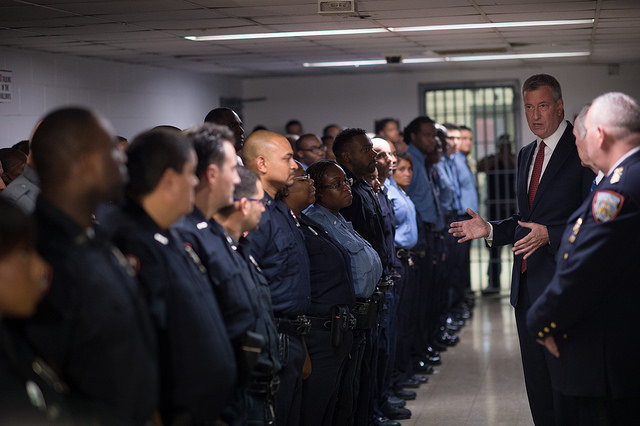
(Michael Appleton/Mayoral Photography Office)
The City of New York, like many cities and states across the country, profits from people experiencing poverty who come into contact with the criminal justice system. New York imposes a plethora of fees on persons charged with and/or convicted of a crime or minor infraction, ranging from a fee to support the DNA Bank, to an incarceration fee, to a fee for parole or probation.
Among the most egregious of these fees involve phone calls in New York City jails. New York City reaps millions of dollars in profits from people who are in city jails and simply want to make a phone call.
Many of these people have not been convicted of a crime. Nearly 75% of people in New York City jails are held pretrial, many because they were arrested and cannot afford to make bail. Some are in jail serving short sentences for minor misdemeanor offenses. All just want to talk with family, friends, or their attorney.
On Monday, the City Council will take the next step in exploring the opportunity to end this predatory practice when it debates a bill, Intro. 0741, introduced by Speaker Corey Johnson. The bill would put a stop to the City’s practice of using the jail phone as a revenue center. Passing it would be a first and important step toward ending what is truly a tax on justice.
Over the last 30 years, as rates of arrest and incarceration skyrocketed across the country, jurisdictions struggled to pay for the bloated justice system. Cities, counties, and states increasingly tried to generate revenue by imposing fees on people, including children, arrested for and convicted of crimes. In California, the state adds $390 in fees to the $100 fine imposed for running a red light. In Washington State, courts impose an average of $1,347 on every criminal conviction. In New York, people convicted of felonies face mandatory fees of $300; for misdemeanor convictions, the fee is $175.
Although the criminal justice system is a vital government service meant to protect everyone’s public safety, more and more jurisdictions turned toward a “user-funded” system, unfairly demanding that some of the poorest Americans shoulder the burden.
Justice system fees disproportionately harm low-income people and their families who cannot afford to pay them. Communities of color are particularly devastated because they experience higher rates of poverty and over-policing in their communities. It is a burden that is often too heavy to bear. For the millions of people who cannot afford to pay them, outstanding fees trap them in the justice system for prolonged periods, entrenching poverty, exacerbating racial and ethnic disparities, and diminishing trust in government. And, because so many people cannot afford to pay them, criminal justice fees often generate less revenue than expected.
Some local and state governments have gone beyond simply trying to recoup costs through justice system fees and are trying to generate profits by imposing fees on people who are incarcerated, regardless of whether they have been convicted of any crime. In jurisdictions across the country, fees for “services” in jails and prisons (including exorbitant mark-ups on items for sale in the commissary) as well as fees for mail and “video” visitation are routinely imposed. New York City’s phone fee is a prime example of this unjust, discriminatory, and misguided policy.
Like all justice system fees, the phone fee particularly harms the city’s most vulnerable communities. It may also diminish public safety. When people in jail can’t afford to pay for phone calls, they can be cut off from contact with their families. Research shows that regular communication between incarcerated people and their loved ones correlates with lower recidivism and higher opportunity for successful re-entry to society.
We know the phone fee disproportionately harms people experiencing poverty and communities of color and may lead to higher recidivism rates. Yet, New York City government plans to extract millions of dollars next year from families who wish to stay in contact with their loved ones in City jails. Indeed, the mayor’s proposed budget anticipates that the Department of Corrections will collect nearly $6 million in profits from phone calls made by people incarcerated in city jails. But, budget negotiations between the de Blasio administration and the City Council have until the end of June to get it right.
The Council Speaker’s bill would stop the City from profiting from people who have already been targeted and trapped by a system that takes away freedom, dignity, and hope. It would help ensure that people who are incarcerated maintain critical community ties while they are in jail, increasing their opportunity for successful re-entry when they are released. It should be adopted by the Council and signed by the mayor.
***
Joanna Weiss is the Co-Director of the Fines and Fees Justice Center. Brandon J. Holmes is the #CLOSErikers Campaign Coordinator for JustLeadershipUSA. On Twitter @joannagweiss and @BJHolmes_NYC.
***
Have an op-ed idea or submission for Gotham Gazette? Email This email address is being protected from spambots. You need JavaScript enabled to view it.
Shola Olatoye Did a Lot of Good for NYCHA
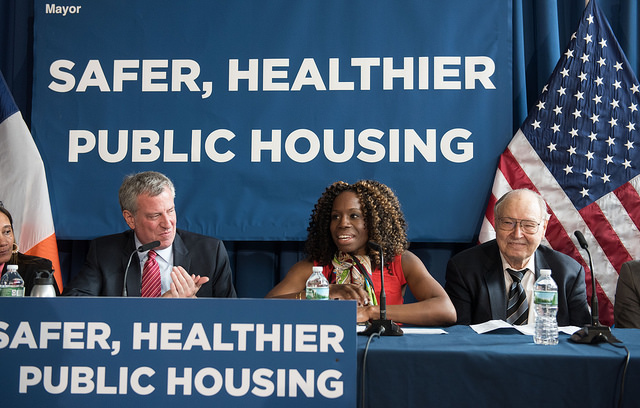
Outgoing NYCHA Chair Olatoye, center (photo: Michael Appleton/Mayor's Office)
As faith leaders in communities with large populations of NYCHA residents, we have witnessed the results of chronic disinvestment in public housing first-hand. NYCHA’s aging buildings are crumbling and many residents are worried about the health and safety of their children, elders, and neighbors.
Since 2001, NYCHA has been shortchanged $3 billion in federal operating and capital funding. NYCHA has been struggling to maintain and repair its aging housing stock for decades. And this is larger than New York City, public housing authorities all over the country are set up to fail, facing gutted budgets and regulatory barriers.
When she took her post as Chair and CEO of NYCHA, Shola Olatoye knew she needed to address these problems, so she worked with communities to make a plan. Under her leadership, we developed NextGeneration NYCHA, a 10-year plan to preserve and protect public housing for current residents as well as the next generation of New Yorkers and beyond. That plan became the road forward to safe, healthy, connected homes and communities for NYCHA residents.
Four years later, as NYCHA has strived to meet the NextGen goals, we have begun to see positive changes for the lives NYCHA residents. Under NextGen NYCHA, about 8,000 residents have been placed in jobs and 18,000 have been connected with services. NYCHA launched 14 new Youth Leadership Councils to give young people the tools they need to work with NYCHA leadership to help make policy decisions that impact the quality of life of NYCHA residents, and empower them to bring their perspective to the table.
We have also seen repair response times reduced from an average of 13 days down to four days and new “FlexOps” schedules that make frontline staff available for longer service hours. NYCHA has achieved more than $313 million in savings from NextGen initiatives and NYCHA has built up nearly 3 months of operating reserves. We are proud to have served on NYCHA’s Faith Leaders Committee and are grateful for Chair Olatoye’s leadership over the last four years.
To be clear, NYCHA’s problems didn’t come with the Chair and they certainly aren’t leaving with her. It is also now up to all of us to continue to fight for the 400,000 New Yorkers who call NYCHA home. We all bear some of the burden to fix this.
We are heartened to hear the commitment of Mayor de Blasio to the NextGeneration NYCHA plan, and hope the new Chair will continue to build upon this progress. We look forward to continuing to serve on NYCHA’s Faith Leaders Committee, supporting the incoming leadership, and working together for a brighter future.
***
Rev. Marc Rivera leads Primitive Christian Church and Rev. Al Cockfield leads God’s Battalion of Prayer Church.
***
Have an op-ed idea or submission for Gotham Gazette? Email This email address is being protected from spambots. You need JavaScript enabled to view it.